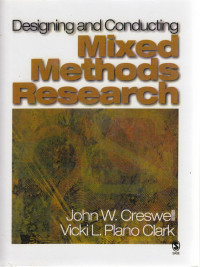
Text
Designing and Conducting Mixed Methods Research
“Designing and Conducting Mixed Methods Research” combines the latest thinking about mixed methods research designs with practical, step-by-step guidelines for the decisions that must be made in designing a mixed methods research study. "Mixed methods research" is defined as a procedure for collecting, analyzing, and mixing both quantitative and qualitative data in a single case study or series of studies and is becoming more common in studies across the social, behavioral, and health sciences as well as education.
The Mixed Methods Reader is divided into two parts: Part I – Methodological Selections and Part II – Exemplar Research Studies. Part I includes a collection of 14 foundational writings from the mixed methods research literature. These readings convey the overall development and evolution of mixed methods research and address essential topics for researchers new to the field of mixed methods research. These topics include its foundations; design types; implementation issues such as sampling, data analysis, and validity; rhetorical devices for reporting mixed methods studies; and critiques about the current thinking in the field. Part II includes 9 exemplar mixed methods research studies drawn from a range of disciplines and international scholars. The studies were intentionally selected to illustrate four major types of mixed methods designs. As with the methodological chapters, the editors organize the exemplar research studies so that the reader can see a natural progression of the different approaches to conducting mixed methods research.
Ketersediaan
| B00675 | 001.42 CRE d | My Library | Tersedia |
Informasi Detail
- Judul Seri
-
-
- No. Panggil
-
001.42 CRE d
- Penerbit
- California : SAGE Publications., 2007
- Deskripsi Fisik
-
xviii, 276 pages : illustration , 24 cm.
- Bahasa
-
English
- ISBN/ISSN
-
9781412927925
- Klasifikasi
-
001.42
- Tipe Isi
-
text
- Tipe Media
-
unmediated
- Tipe Pembawa
-
volume
- Edisi
-
-
- Subjek
- Info Detail Spesifik
-
-
- Pernyataan Tanggungjawab
-
-
Versi lain/terkait
Tidak tersedia versi lain
Komentar
Anda harus masuk sebelum memberikan komentar
 Karya Umum
Karya Umum  Filsafat
Filsafat  Agama
Agama  Ilmu-ilmu Sosial
Ilmu-ilmu Sosial  Bahasa
Bahasa  Ilmu-ilmu Murni
Ilmu-ilmu Murni  Ilmu-ilmu Terapan
Ilmu-ilmu Terapan  Kesenian, Hiburan, dan Olahraga
Kesenian, Hiburan, dan Olahraga  Kesusastraan
Kesusastraan  Geografi dan Sejarah
Geografi dan Sejarah  E-Book
E-Book